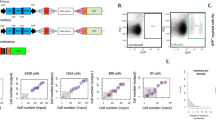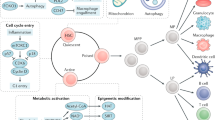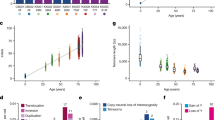Abstract
Genetic defects that accumulate in haematopoietic stem cells (HSCs) are thought to be responsible for age-related changes in haematopoiesis that include a decline in lymphopoiesis and skewing towards the myeloid lineage. This HSC-centric view is based largely on studies showing that HSCs from aged mice exhibit these lineage biases following transplantation into irradiated young recipient mice. In this Opinion article, we make the case that the reliance on this approach has led to inaccurate conclusions regarding the effects of ageing on blood-forming stem cells; we suggest instead that changes in the environment contribute to haematopoietic system ageing. We propose that a complete understanding of how ageing affects haematopoiesis depends on the analysis of blood cell production in unperturbed mice. We describe how this can be achieved using in situ fate mapping. This approach indicates that changes in downstream progenitors, in addition to any HSC defects, may explain the reduced lymphopoiesis and sustained myelopoiesis that occur during ageing.
This is a preview of subscription content, access via your institution
Access options
Access Nature and 54 other Nature Portfolio journals
Get Nature+, our best-value online-access subscription
$29.99 / 30 days
cancel any time
Subscribe to this journal
Receive 12 print issues and online access
$209.00 per year
only $17.42 per issue
Buy this article
- Purchase on Springer Link
- Instant access to full article PDF
Prices may be subject to local taxes which are calculated during checkout


Similar content being viewed by others
References
Geiger, H., de Haan, G. & Florian, M. The ageing haematopoietic stem cell compartment. Nat. Rev. Immunol. 13, 376–389 (2013).
Montecino-Rodriguez, E., Berent-Maoz, B. & Dorshkind, K. Causes, consequences and reversal of immune system aging. J. Clin. Invest. 123, 958–965 (2013).
Pang, W. et al. Human bone marrow hematopoietic stem cells are increased in frequency and myeloid-biased with age. Proc. Natl Acad. Sci. USA 108, 20012–20017 (2011).
Riley, R., Blomberg, B. & Frasca, D. B cells, E2A, and aging. Immunol. Rev. 205, 30–47 (2005).
Min, H., Montecino-Rodriguez, E. & Dorshkind, K. Effects of aging on early B- and T-cell development. Immunol. Rev. 205, 7–17 (2005).
Miller, J. P. & Allman, D. The decline in B lymphopoiesis in aged mice reflects loss of very early B-lineage precursors. J. Immunol. 171, 2326–2330 (2003).
Johnson, K. M., Owen, K. & Witte, P. L. Aging and developmental transitions in the B cell lineage. Int. Immunol. 14, 1313–1323 (2002).
Min, H., Montecino-Rodriguez, E. & Dorshkind, K. Effects of aging on the common lymphoid progenitor to pro-B cell transition. J. Immunol. 176, 1007–1012 (2006).
Dykstra, B., Olthof, S., Schreuder, J., Ritsema, M. & De Haan, G. Clonal analysis reveals multiple functional defects of aged murine hematopoietic stem cells. J. Exp. Med. 208, 2691–2703 (2011).
De Haan, G. & Lazare, S. Aging of hematopoietic stem cells. Blood 131, 479–487 (2018).
Wahlestedt, M., Pronk, C. & Bryder, D. Concise review: hematopoietic stem cell aging and the prospects for rejuvenation. Stem Cells Transl Med. 4, 186–194 (2015).
Rossi, D. J. et al. Cell intrinsic alterations underlie hematopoietic stem cell aging. Proc. Natl Acad. Sci. USA 102, 9194–9199 (2005).
Sudo, K., Ema, H., Morita, Y. & Nakauchi, H. Age-associated characteristics of murine hematopoietic stem cells. J. Exp. Med. 192, 1273–1280 (2000).
Florian, M. et al. Cdc42 activity regulates hematopoietic stem cell aging and rejuvenation. Cell Stem Cell 10, 520–530 (2012).
Mann, M. et al. Heterogeneous responses of hematopoietic stem cells to inflammatory stimuli are altered with age. Cell Rep. 25, 2992–3005 (2018).
Maryanovich, M. et al. Adrenergic nerve degeneration in bone marrow drives aging of the hematopoietic stem cell niche. Nat. Med. 24, 782–791 (2018).
Ho, Y. et al. Remodeling of bone marrow hematopoietic stem cell niches promotes myeloid cell expansion during premature or physiologic aging. Cell Stem Cell 25, 1–12 (2019).
Pioli, P., Casero, D., Montecino-Rodriguez, E., Morrison, S. & Dorshkind, K. Plasma cells are obligate effectors of enhanced myelopoiesis in aging bone marrow. Immunity 51, 351–366 (2019).
Busch, K. & Rodewald, H.-R. Unperturbed vs. post-transplantation hematopoeisis: both in vivo but different. Curr. Opin. Hematol. 23, 295–303 (2016).
Lu, R., Czechowica, A., Seita, J., Jiang, D. & Weissman, I. Clonal-level lineage commitment pathways of hematopoietic stem cells in vivo. Proc. Natl Acad. Sci. USA 116, 1447–1456 (2019).
Wilkinson, F. et al. Busulfan conditioning enhances engraftment of hematopoietic donor-derived cells in the brain compared with irradiation. Mol. Ther. 21, 868–876 (2013).
Xun, C., Thompson, J., Jennings, C., Brown, S. & Widmer, M. Effect of total body irradiation, busulfan-cyclophosphamide, or cyclophosphamide conditioning on inflammatory cytokine release and development of acute and chronic graft-versus-host disease in H-2-incompatible transplanted SCID mice. Blood 83, 2360–2367 (1994).
Henry, C. et al. Aging-associated inflammation promotes selection for adaptive oncogenic events in B cell progenitors. J. Clin. Invest. 125, 4666–4680 (2015).
Youshani, A. et al. Non-myeloablative busulfan chimeric mouse models are less pro-inflammatory than head-shielded irradiation for studying immune cell interactions in brain tumors. J. Neuroinflammation 16, 25 (2019).
King, K. & Goodell, M. Inflammatory modulation of HSCs: viewing the HSC as a foundation for the immune response. Nat. Rev. Immunol. 11, 685–692 (2011).
Nagai, Y. et al. Toll-like receptors on hematopoietic progenitor cells stimulate innate immune system replenishment. Immunity 24, 801–812 (2006).
Mirantes, C., Passegue, E. & Pietras, E. Pro-inflammatory cytokines: emerging players regulating HSC function in normal and diseased hematopoiesis. Exp. Cell Res. 329, 248–254 (2014).
Kovtonyuk, L., Fritsch, K., Feng, X., Manz, M. & Takizawa, H. Inflamm-aging of hematopoiesis, hematopoietic stem cells, and the bone marrow microenvironment. Front. Immunol. 7, 502 (2016).
Baldridge, M., King, K. & Goodel, M. Inflammatory signals regulate hematopoietic stem cells. Trends Immunol. 32, 57–65 (2011).
Pietras, E. Inflammation: a key regulator of hematopoietic stem cell fate in health and disease. Blood 130, 1693–1698 (2017).
Ueda, Y., Kondo, M. & Kelsoe, G. Inflammation and the reciprocal production of granulocytes and lymphocytes in bone marrow. J. Exp. Med. 201, 1771–1780 (2005).
Pietras, E. et al. Chronic interleukin-1 exposure drives haematopoietic stem cells towards precocious myeloid differentiation at the expense of self-renewal. Nat. Cell Biol. 18, 607–618 (2016).
Dorshkind, K. Interleukin-1 inhibition of B lymphopoiesis is reversible. Blood 72, 2053–2055 (1988).
Ergen, A., Boles, N. & Goodell, M. Rantes/Ccl5 influences hematopoietic stem cell subtypes and causes myeloid skewing. Blood 119, 2500–2509 (2012).
Kennedy, D. & Knight, K. Inflammatory changes in bone marrow microenvironment associated with declining B lymphopoiesis. J. Immunol. 198, 3471–3479 (2017).
Dorshkind, K. IL-1 inhibits B cell differentiation in long term bone marrow cultures. J. Immunol. 141, 531–538 (1988).
Maeda, K. et al. IL-6 blocks a discrete early step in lymphopoiesis. Blood 106, 879–885 (2005).
Takizawa, H., Boettcher, S. & Manz, M. Demand-adapted regulation of early hematopoiesis in infection and inflammation. Blood 119, 2991–3002 (2012).
Fransceschi, C., Garagnani, P., Parini, P., Giuliani, C. & Santoro, A. Inflammaging: a new immune-metabolic viewpoint for age-related diseases. Nat. Rev. Endocrinol. 14, 576–590 (2018).
Schaue, D., Kackikwu, E. & McBride, W. Cytokines in radiobiological responses: a review. Radiat. Res. 178, 505–523 (2012).
Muller-Sieburg, C., Cho, R., Karlsson, L., Huang, J. & Sieburg, H. Myeloid-biased hematopoietic stem cells have extensive self-renewal capacity but generate diminished lymphoid progeny with impaired IL-7 responsiveness. Blood 103, 4111–4118 (2004).
Dykstra, B. et al. Long-term propagation of distinct hematopoietic differentiation programs in vivo. Cell Stem Cell 1, 218–229 (2007).
Beerman, I. et al. Functionally distinct hematopoietic stem cells modulate hematopoietic lineage potential during aging by a mechanism of clonal expansion. Proc. Natl Acad. Sci. USA 107, 5465–5470 (2010).
Challen, G., Boles, N., Chambers, S. & Goodell, M. Distinct hematopoietic stem cells subtypes are differentially regulated by TGF-β1. Cell Stem Cell 6, 265–278 (2010).
Morita, Y., Ema, H. & Nakauchi, H. Heterogeneity and hierarchy within the most primitive hematopoietic stem cell compartment. J. Exp. Med. 207, 1173–1182 (2010).
Montecino-Rodriquez, E. et al. Lymphoid biased hematopoietic stem cells are maintained with age and efficiently generate lymphoid progeny. Stem Cell Rep. 12, 584–596 (2019).
Cho, R., Sieburg, H. & Muller-Sieburg, C. A new mechanism for the aging of hematopoietic stem cells: aging changes the clonal composition of the stem cell compartment but not the individual stem cells. Blood 111, 5553–5561 (2008).
Wahlestedt, M. et al. Clonal reversal of ageing-associated stem cell lineage bias via a pluripotent intermediate. Nat. Commun. 8, 14533 (2017).
Young, K. et al. Progressive alterations in multipotent hematopoietic progenitors underlie lymphoid cell loss in aging. J. Exp. Med. 213, 2259–2287 (2016).
Yeager, A., Shinn, C. & Pardoll, D. Lymphoid reconstitution after transplantation of congenic hematopoietic cells in busulfan-treated mice. Blood 78, 3312–3316 (1991).
Hsieh, M. et al. Low-dose parenteral busulfan provides an extended window for the infusion of hematopoietic stem cells in murine hosts. Exp. Hematol. 35, 1415–1420 (2007).
Liang, Y., Van Zant, G. & Szilvassy, S. Effects of aging on the homing and engraftment of murine hematopoietic stem and progenitor cells. Blood 106, 1479–1480 (2006).
Morrison, S. J., Wandycz, A. M., Akashi, K., Globerson, A. & Weissman, I. L. The aging of hematopoietic stem cells. Nat. Med. 2, 1011–1016 (1996).
Sun, J. et al. Clonal dynamics of native haematopoiesis. Nature 514, 322–327 (2014).
Gazit, R. et al. Fgd5 identifies hematopoietic stem cells in the murine bone marrow. J. Exp. Med. 211, 1315–1331 (2014).
Busch, K. et al. Fundamental properties of unperturbed haematopoiesis from stem cells in vivo. Nature 518, 542–546 (2015).
Sawai, C. et al. Hematopoietic stem cells are the major source of multilineage hematopoiesis in adult animals. Immunity 45, 597–609 (2016).
Pei, W. et al. Polylox barcoding reveals haematopoeitic stem cell fates realized in vivo. Nature 548, 456–460 (2017).
Oguro, H., Ding, L. & Morrison, S. SLAM family markers resolve functionally distinct subpopulations of hematopoietic stem cells and multipotent progenitors. Cell Stem Cell 13, 102–116 (2013).
Säwen, P. et al. Murine HSCs contribute actively to native hematopoiesis but with reduced differentiation capacity upon aging. eLife 7, e41258 (2018).
Hofer, T., Busch, K., Klapproth, K. & Rodewald, H.-R. Fate mapping and quantitation of hematopoiesis in vivo. Annu. Rev. Immunol. 34, 4490478 (2016).
Hofer, T. & Rodewald, H.-R. Differentiation-based model of hematopoietic stem cell functions and lineage pathways. Blood 132, 1106–1113 (2018).
Ito, K. et al. Self-renewal of a purified Tie2+ hematopoietic stem cell population relies on mitochondrial clearance. Science 354, 1156–1160 (2016).
Schoedel, K. et al. The bulk of the hematopoietic stem cell population is dispensable for murine steady-state and stress hematopoiesis. Blood 128, 2285–2296 (2016).
Sheikh, B. et al. MOZ (KAT6A) is essential for the maintenance of classically defined adult hematopoietic stem cells. Blood 128, 2307–2318 (2016).
Lu, R., Neff, N., Quake, S. & Weissman, I. Tracking single hematopoietic stem cells in vivo using high-throughput sequencing in conjunction with viral genetic barcoding. Nat. Biotechnol. 29, 928–933 (2011).
Gerrits, A. et al. Cellular barcoding tool for clonal analysis in the hematopoietic system. Blood 115, 2610–2618 (2010).
Geiger, H., Denkiger, M. & Schimbeck, R. Hematopoietic stem cell aging. Curr. Opin. Immunol. 29, 86–92 (2014).
Chapple, R. et al. Lineage tracing of murine adult hematopoietic stem cells reveals active contribution to steady-state hematopoiesis. Blood Adv. 2, 1220–1228 (2018).
Upadhaya, S., Reizis, B. & Sawai, C. New genetic tools for the in vivo study of hematopoietic stem cell function. Exp. Hematol. 61, 26–35 (2018).
Wilson, A. et al. Hematopoietic stem cells reversibly switch from dormancy to self-renewal during homeostasis and repair. Cell 135, 1118–11129 (2008).
Akashi, K., Traver, D., Miyamoto, T. & Weissman, I. L. A clonogenic common myeloid progenitor that gives rise to all myeloid lineages. Nature 404, 193–197 (2000).
Kondo, M., Weissman, I. L. & Akashi, K. Identification of clonogenic common lymphoid progenitors in mouse bone marrow. Cell 91, 661–672 (1997).
Anam, K., Black, A. & Hale, D. Low dose busulfan facilitates chimerism and tolerance in a murine model. Transpl. Immunol. 15, 199–204 (2006).
Martins, V. et al. Cell competition is a tumour suppressor mechanism in the thymus. Nature 509, 465–470 (2014).
Signer, R. A. J., Montecino-Rodriguez, E., Witte, O. N. & Dorshkind, K. Aging and cancer resistance in lymphoid progenitors are linked processes conferred by p16Ink4a and Arf. Genes Dev. 22, 3115–3120 (2008).
King, A. M., Van der Put, E., Blomberg, B. B. & Riley, R. L. Accelerated notch-dependent degradation of E47 proteins in aged B cell precursors is associated with increased ERK MAPK activation. J. Immunol. 178, 3521–3529 (2007).
Labrie, J. E., Sah, A. P., Allman, D. M., Cancro, M. P. & Gerstein, R. M. Bone marrow microenvironmental changes underlie reduced RAG-mediated recombination and B cell generation in aged mice. J. Exp. Med. 200, 411–423 (2004).
Geiger, H. & Van Zant, G. The aging of lympho-hematopoietic stem cells. Nat. Immunol. 3, 329–333 (2002).
Sun, D. et al. Epigenomic profiling of young and aged HSCs reveals concerted changes during aging that reinforce self-renewal. Cell Stem Cell 14, 673–688 (2014).
Chambers, S. et al. Aging hematopoietic stem cells decline in function and exhibit epigentic dysregulation. PLOS Biol. 5, e201 (2007).
Kowalczyk, M. et al. Single-cell RNA-seq reveals changes in cell cycle and differentiation programs upon aging of hematopoietic stem cells. Genome Res. 25, 1860–1872 (2015).
Grover, A. et al. Single-cell RNA sequencing reveals molecular and functional platelet bias of aged haematopoietic stem cells. Nat. Commun. 7, 11075 (2016).
Rundberg Nilsson, A., Soneji, S., Adolfsson, S., Bryder, D. & Pronk, C. Human and murine hematopoietic stem cell aging is associated with functional impairments and intrinsic megakaryocytic/erythroid bias. PLOS ONE 11, e0158369 (2016).
Kirschner, K. et al. Proliferation drives aging-related functional decline in a subpopulation of the hematopoietic stem cell compartment. Cell Rep. 19, 1503–1511 (2017).
Benz, C. et al. Hematopoietic stem cell subtypes expand differentially during development and display distinct lymphopoietic programs. Cell Stem Cell 10, 273–283 (2012).
Mohrin, M. et al. A mitochondrial UPR-mediated metabolic checkpoint regulates hematopoietic stem cell aging. Science 347, 1374–1377 (2015).
Chen, C. Y., Liu, Y. & Zheng, P. mTOR regulation and therapeutic rejuvenation of aging hematopoietic stem cells. Sci. Signal. 2, ra75 (2009).
Leins, H. et al. Aged murine hematopoietic stem cells drive aging-associated immune remodeling. Blood 132, 565–576 (2018).
Ghosh, S., Twarri, R., Dixit, D. & Sen, E. TNF α induced oxidative stress dependent Akt signaling affects actin cytoskeletal organization in glioma cells. Neurochem. Int. 56, 194–201 (2010).
Gadea, G. et al. TNFα induces sequenctial activation of Cdc42- and p38/p53-dependent pathways that antagonistically regulate filopodia formation. J. Cell Sci. 117, 6355–6364 (2004).
Razidlo, G., Burton, K. & McNiven, M. Interleukin-6 promotes pancreatic cancer cell migration by rapidly activating the small GTPase CDC42. J. Biol. Chem. 293, 11143–11153 (2018).
Acknowledgements
The authors’ research presented here was supported by grants to K.D. from the US National Institutes of Health (AG056480), Deutsche Forschungsgemeinschaft DFG-SFB 873-B11 to T.H. and H.-R.R., and European Research Council Advanced Grant 742883 and DFG Leibniz program to H.-R.R.
Author information
Authors and Affiliations
Contributions
All authors contributed to the development of concepts and/or the writing of the manuscript.
Corresponding authors
Ethics declarations
Competing interests
The authors declare no competing interests.
Additional information
Peer review information
Nature Reviews Immunology thanks F. Camargo, S. Morrison and the other, anonymous, reviewer(s) for their contribution to the peer review of this work.
Publisher’s note
Springer Nature remains neutral with regard to jurisdictional claims in published maps and institutional affiliations.
Glossary
- Barcoding
-
Genetic tagging of cells with large numbers of distinct, and ideally unique, labels. Originally this was achieved by analyses of highly diverse integration sites of viral DNA in the genomes of cells infected in vitro, followed by cell transplantation and tracking of barcodes in progeny. More recently, endogenous barcoding has been developed, in which cells can be tagged in whole organisms without the need for cell manipulations in vitro. Examples of endogenous techniques include CRISPR–Cas9-based methods, transposon integration site analysis and Cre-dependent Polylox barcoding. When the probability of induction of a given barcode is smaller than the target population, it becomes highly likely that single cells are being labelled. Hence, endogenous barcoding can reveal precursor–product relationships emerging from single stem cells and can provide insights into lineage relationships.
- Conditioning
-
The treatment of recipients before transplantation in order to create space in the bone marrow to allow for donor bone marrow cells to engraft. Conditioning regimens include drugs, such as 1,4-butanediol dimethanesulfonate (busulfan), and/or ionizing irradiation that kills endogenous stem and progenitor cells.
- Fate-mapping approaches
-
Experimental approaches in which a single genetic switch, usually lineage-specific or stage-specific and sometimes inducible, is used to turn on a heritable marker in stem or progenitor cells. All progeny that arise from labelled cells can be tracked, which yields information on precursor–product relationships and on the flow of differentiation. Combined with mathematical analysis and modelling, fate mapping can reveal in situ frequencies of differentiating stem cells and progenitors and differentiation rates, independent of the vagaries of cell transplantation. The inducible Cre systems referred to in this article include Tie2–MerCreMer mice, Pdzk1ip1–CreER mice and Fgd5–CreERT2 mice.
- Irradiation
-
Process in which a subject is exposed to radiation. Ionizing radiation can be delivered from caesium137 or cobalt60 γ-irradiators or X-ray devices. Both γ radiation and X-rays are highly penetrating and can travel into tissue, and as a result these forms of radiation are frequently used to deplete haematopoietic cells from the bone marrow before transplantation.
Rights and permissions
About this article
Cite this article
Dorshkind, K., Höfer, T., Montecino-Rodriguez, E. et al. Do haematopoietic stem cells age?. Nat Rev Immunol 20, 196–202 (2020). https://doi.org/10.1038/s41577-019-0236-2
Accepted:
Published:
Issue Date:
DOI: https://doi.org/10.1038/s41577-019-0236-2
This article is cited by
-
Neutrophil, lymphocyte count, and neutrophil to lymphocyte ratio predict multimorbidity and mortality—results from the Baltimore Longitudinal Study on Aging follow-up study
GeroScience (2024)
-
Epigenetic traits inscribed in chromatin accessibility in aged hematopoietic stem cells
Nature Communications (2022)
-
C-type lectin-like receptor 2 specifies a functionally distinct subpopulation within phenotypically defined hematopoietic stem cell population that contribute to emergent megakaryopoiesis
International Journal of Hematology (2022)
-
Investigating Adult Stem Cells Through Lineage analyses
Stem Cell Reviews and Reports (2022)
-
Expansion of Quiescent Hematopoietic Stem Cells under Stress and Nonstress Conditions in Mice
Stem Cell Reviews and Reports (2022)



